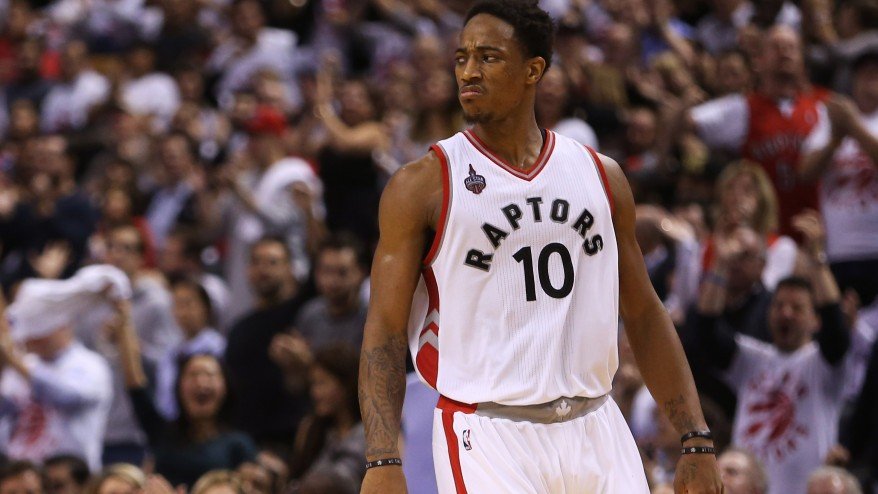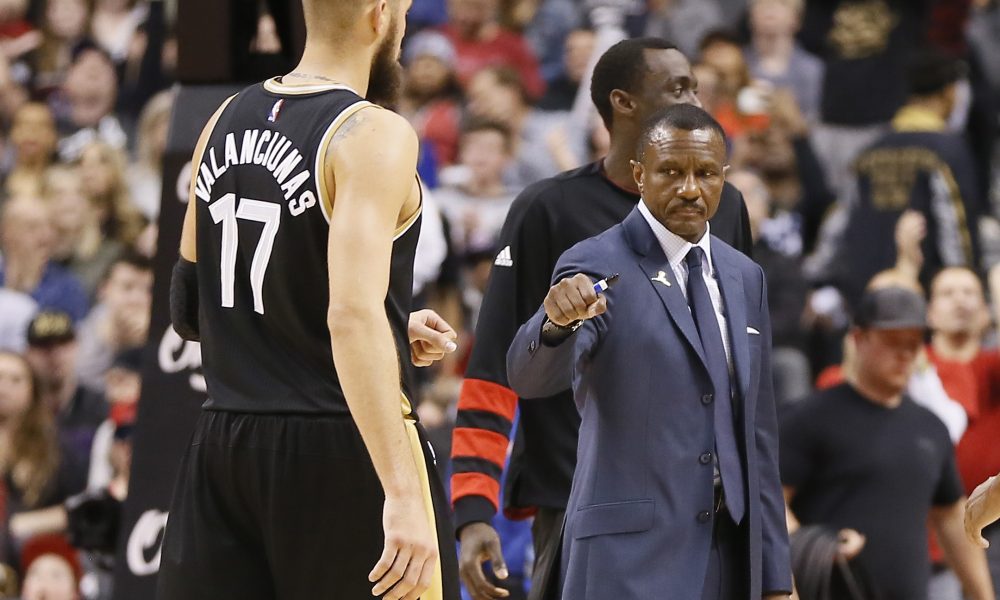I’ve written and said some stupid stuff about Demar DeRozan over the years, and I’m ashamed looking back how ready I was for him to be anywhere but Toronto. Now I find myself wishing I could be like DeRozan.
I don’t mean this so much in the sense of his basketball abilities (although that would be exceedingly fun) because I realized many years ago that I was only good enough for a low-level of rec league action, but more so in the way he continually improves himself.
The simple life is what I enjoy. Perhaps it is apathy, but I prefer to think of it as a high level of contentment. I’ve got a job I like and I do my tasks well. I also enjoy time with family and friends, and like to sit and take in a basketball game whenever possible. And while I do go to the gym regularly (humble brag?), I’m still not one steeped in the art of self-development and personal betterment like DeMar.
Having been drafted 9th overall in 2009 DeRozan is an almost unrecognizable player in his 9th season. 631 games played, 619 starts (hasn’t come off the bench since his rookie year), and having become one of the most successful Raptors in history, it has been a delight (although frustrating at times) to watch him become what he is.
Just look at what DraftExpress (RIP) wrote about DeRozan prior to the draft:
Whichever team drafts Demar DeRozan will be picking him in the hopes that hell growing into their system, and not because hes already a great fit.Unlike every other player in our analysis, DeRozan doesnt make a living in any one situation, though he is one of the most efficient players on our list. In our last piece we discussed the new %Score stat which indicates how frequently a player scored a point based on their logged possessions. DeRozan ranks first amongst the nineteen players on our list at 54.4%. However, he ranks only 16th in overall PPP. This disparity stems from the fact that he shoots nearly three less three-pointers per game than the average player on our list (4.3 vs. 1.3) and ranks last in terms of three-point percentage at just 16.7%. He doesnt get to the free throw line at a great rate to compensate and only converts on a mediocre 65% of his attempts once there. He makes up for that by shooting 49% from the field on his isolation opportunities (4th), knocking down his catch and shoot jumpers at a 43% clip (6th), and hitting 41% of his pull ups as well (4th). Clearly DeRozan has a solid knack for operating in the mid-range area, which should serve him well in the more spacing-friendly NBA. Hes also a good offensive reboundera testament to his excellent physical tools.Outside of those areas, DeRozan proves a very average player across the board. His defensive rebounding totals sit just below the mean as does his assists numbers, PPP working off of cuts (1.22) and as a finisher around the rim in general (1.14). He sits a bit further below the average in a number of other situations including spot up (1.02 vs. 0.93) and transition opportunities (1.19 vs 1.03). Considering that he didnt do almost any posting up (0.3 Pos/G) or shooting coming off of screens (0.7 Pos/G), the weight teams put on how significantly they believe he can improve his range and ability to improve his efficiency in a defined system will likely determine where he lands on draft day. A freak athlete, DeRozan has some natural offensive talent, but hes essentially a blank canvas in terms of what kind of player he can be in the long run. Whoever picks him will obviously need to be patient, although he may more upside that arguably any wing player in this draft. – Source: http://www.draftexpress.com/profile/Demar-DeRozan-1319/ ©DraftExpress
Granted, he had his strengths in college, but the terms “blank canvas” and “freak athlete” were spot on looking back. DeRozan was able to operate with some success in the mid-range at USC, but needed to develop/refine almost every area of his basketball skillset once in the NBA.
The first step in his growth was continuing to develop an old-man style of game that he hinted at in college. He focused primarily early in his career on working in the post and hitting a Kobe style turn-around/fade jumper. It wasn’t the most impactful style, but it was a good starting point based on his initial tools coming out of college.
In the years to come DeMar spent entire summers working on perfecting these scoring options, while also learning how to dribble the basketball. This then allowed him to more easily move between the post and the mid-range, and create his own shot in isolation. We went from videos of him dribbling down an aisle in a store during the summer, to moving freely with the ball around an NBA court.
From there, he learned how to create shots for teammates, maximizing scoring options when doubled. It wasn’t enough to create his own space to score, he needed to diversify for when his own options were taken away.
While he didn’t get to the free throw line much in college, and hit only 65 percent of his attempts from the stripe, DeMar has become one of the deadliest players in the league at drawing fouls. Currently ranking fourth in both free throws attempted per game (8) and free throws made per game (6.7), DeMar has made getting to the line an art form of sorts.
And despite doing all of this, there was still a glaring weakness to his game that was always highlighted: three point shooting. He avoided taking them, and even when he did he also avoided making them. As the league boom of three point shooting grew, DeMar seemingly didn’t. Of the league’s top 10 scorers in 2016-17, only three attempted less than 5 three pointers per game: LeBron James (4.6), Anthony Davis (1.8), and DeMar DeRozan (1.7).
Now it appears that DeMar has even added that, increasing his three point attempts per game to a career high 3.2. One the season he has shot 37 percent from three, all despite starting the season looking worse than ever.
Through the first 26 games of the season DeMar was matching last season’s three point attempts mark at 1.7 per game, while shooting just 27 percent from distance. Since then he has been a revelation over the last 10 games, attempting 4.9 threes per game and hitting 2.6 of them.
He’s shooting 53.1 percent from three point range over a 10 game stretch. That’s a small sample size for certain, but with each passing game it feels like another leap has been taken in his progression as a player. There is a confidence in his shot that hasn’t been there in the past. Rather than just taking catch-and-shoot attempts from deep, he is also creating his own looks with the ball in his hands, keeping opponents on their toes with the variety of ways he can now score.
Will DeMar continue to shoot 53 percent from three for the remainder of the season? Certainly not. But if he can at least be league average (around 37 percent) as he has been so far on the entire season, that itself is a huge accomplishment. DeMar becoming a three point shooter helps open up more looks for teammates, and more line-up options for Casey to work with.
He is currently one of just seven players in the league to score at least 25 points, while having at least 5 assists and 4 rebounds, putting him alongside James Harden, LeBron James, Steph Curry, DeMarcus Cousins, Kevin Durant, and Damian Lillard. Not a bad group to be with.
With most superstars the transformation seemingly happens overnight. They find the one weapon they need to maximize their skills, or figure out how to use their physical tools to take over a game. One day it just seems to click, and a star is born.
DeMar seemingly falls into a different category. He is not an overnight hero, but it has been a slow and steady process. Though in every sense of the word DeMar has earned the title of Superstar, one year at a time.




